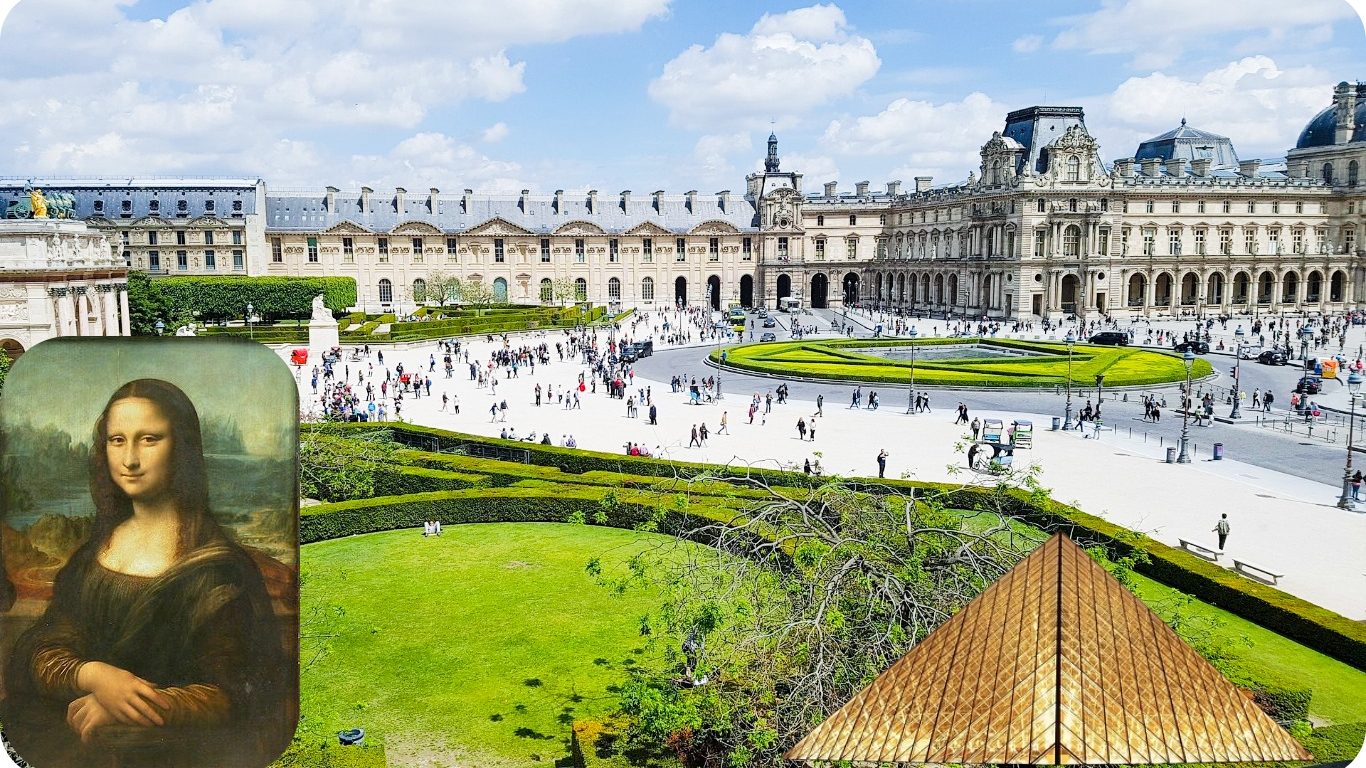Louvre Museum, Paris
A Complete Guide
to Art, History & Visiting Tips
“Step inside the world’s most visited museum and uncover its iconic artworks, royal history, and expert tips for making the most of your visit to the Louvre Museum, Paris.”

Louvre Museum, Paris: Where Art, History, and Culture Converge
More than simply the world’s largest art museum, the Louvre Museum, Paris stands as a powerful emblem of France’s rich cultural legacy and historic heritage. Situated in the heart of the city, along the serene banks of the Seine River, the Louvre welcomes over 10 million visitors annually. From ancient civilizations to iconic works like the Mona Lisa, this remarkable institution is more than a museum — it’s an epic journey through the soul of humanity.
In this comprehensive blog post, we explore everything you need to know about the Louvre Museum, Paris — including its storied history, architectural grandeur, celebrated collections, and insider tips for your visit.
A Glimpse into the Louvre’s Legendary Past
Long before it opened its doors to the public, the Louvre Museum, Paris served as a royal residence, originally built in the late 1100s by King Philippe Auguste as a fortified stronghold defending Paris from potential attackers. Over time, it evolved into a Renaissance palace, hosting monarchs like François I and Louis XIV, before eventually transforming into a museum after the French Revolution in 1793.
The revolution opened the doors of the royal collections to the public, signaling a shift in power and the democratization of culture. It was a radical concept at the time — art that once belonged only to kings was now for everyone.
Today, the Louvre Museum, Paris preserves that revolutionary spirit, showcasing over 380,000 objects, with more than 35,000 works on display at any given time.
The Iconic Louvre Pyramid: A Blend of Modern and Classic
Among the Louvre Museum, Paris’s most memorable landmarks is its breathtaking glass pyramid, introduced in 1989 by visionary Chinese-American architect I.M. Pei. Initially controversial, the pyramid has become a beloved symbol of the museum — a perfect blend of modernity amid historic grandeur.
Rising 21.6 meters and formed from 673 glass panels, this pyramid acts as the museum’s primary entry point. Its transparency contrasts beautifully with the classical architecture of the palace, making it one of the most photographed landmarks in Paris.
Must-See Masterpieces at the Louvre Museum, Paris
Exploring the Louvre Museum, Paris can feel daunting because of its vast scale and the impressive depth of its collections. Here are some must-see masterpieces that no visitor should miss:
🖼 Mona Lisa – Leonardo da Vinci
Arguably the most famous painting in the world, the Mona Lisa draws millions of visitors each year. Despite its modest size (77 x 53 cm), the mysterious smile of La Gioconda continues to captivate audiences.
🗿 The Venus de Milo – Alexandros of Antioch
This ancient Greek statue of Aphrodite dates back to 100 BC and is admired for its elegant form and enigmatic expression — despite its missing arms.
🎨 Liberty Leading the People – Eugène Delacroix
A powerful representation of freedom, this large-scale painting depicts Marianne, the symbol of the French Republic, leading citizens during the July Revolution of 1830.
🏛 The Winged Victory of Samothrace
Perched at the top of the Darú staircase, this Hellenistic sculpture exudes motion and grace. It stands out as one of the most visually captivating attractions in the entire museum.
The Louvre’s Collections: A Walk-Through Civilizations
The Louvre Museum, Paris is organized into eight distinct departments, each showcasing art and artifacts from diverse eras and civilizations:
1. Egyptian Antiquities
Spanning from 4000 BC to the 4th century AD, this section includes mummies, papyri, and statues, offering a glimpse into ancient Egypt’s grandeur.
2. Greek, Etruscan, and Roman Antiquities
Featuring art from the Mediterranean world, including sarcophagi, pottery, and classical sculpture.
3. Near Eastern Antiquities
From Mesopotamia to the Levant, this section includes the Code of Hammurabi, one of the oldest legal texts in existence.
4. Islamic Art
A newer department, it showcases ceramics, glassware, and textiles from the Islamic world — bridging East and West.
5. Paintings
Over 7,500 paintings, with a strong focus on European works from the 13th to 19th centuries, including Italian Renaissance and French Neoclassicism.
6. Sculptures
Beyond Greek and Roman statues, this department also includes Gothic and Renaissance French sculpture.
7. Decorative Arts
Furniture, tapestries, jewelry, and royal treasures from various eras, including pieces from Napoleon’s reign.
8. Prints and Drawings
Over 140,000 works, including sketches by Michelangelo, Raphael, and Rembrandt, held in the Cabinet des Dessins.
Practical Visitor Tips for the Louvre Museum, Paris
🎟 Book Your Tickets in Advance
Avoid long queues by reserving tickets online. Entry is free for EU residents under 26.
🕘 Best Times to Visit
- To dodge the busiest periods, aim for either an early morning arrival or a late-day visit.
- Wednesday and Friday evenings offer extended hours.
🎧 Guided Tours & Audio Guides
The Louvre offers multilingual audio guides and private tours, which help contextualize the vast collections.
🗺 Use the Museum Map
With over 72,000 square meters of exhibition space, a museum map or the official Louvre app can save time and help prioritize your visit.
🍽 Where to Eat Nearby
Cafés inside the Louvre include Café Marly, while nearby you’ll find Angelina Paris and Le Fumoir for quality dining options.
Louvre Museum, Paris with Kids and Families
The Louvre Museum, Paris is family-friendly, offering:
- Children’s trails and activity booklets
- Workshops and storytelling tours
- Free entry for under-18s
Additionally, the Carrousel du Louvre, the underground shopping mall, includes family-friendly restaurants and rest areas.
Nearby Attractions: What to See Around the Louvre
When you’re done exploring the Louvre Museum, Paris, consider visiting:
🌳 Jardin des Tuileries
Right next to the Louvre, it’s a perfect place to relax, enjoy sculptures, or have a picnic.
🎭 Palais Royal
An architectural gem with tranquil gardens, colonnades, and the iconic Buren Columns.
🛍 Rue Saint-Honoré
A fashionable shopping street offering a mix of haute couture and Parisian charm.
🚤 Seine River Cruise
Set off from the Louvre’s Pont des Arts and experience Paris from a riverside perspective.
Hidden Gems Inside the Louvre Museum, Paris
Aside from the headline pieces, the Louvre holds many lesser-known treasures worth discovering:
🧵 Napoleon III Apartments
An opulent slice of 19th-century elegance — chandeliers, velvet drapes, and imperial décor.
🧩 The Galerie d’Apollon
Home to the French crown jewels, this room is a stunning display of ceiling frescoes and baroque grandeur.
🪞The Medieval Louvre
Explore the original 12th-century fortress foundation, with stone walls and moats in the basement level.
Louvre Museum, Paris in Pop Culture and Film
The Louvre Museum, Paris has captivated not only art lovers but also filmmakers and authors:
- The Da Vinci Code (2006) brought global attention to its secretive allure and architectural beauty.
- Featured in Wonder Woman, Mission: Impossible, and various fashion shows and music videos.
- It remains a favorite for Instagram influencers, with its dazzling pyramid backdrop.
The Louvre at Night: An Enchanted Experience
Exploring the Louvre Museum, Paris at night creates a truly memorable experience. The glass pyramid glows, casting dramatic reflections across the courtyard. The peaceful setting and soft illumination offer a dreamlike way to view some of the finest art on Earth.
Photography is permitted (without flash), and night tours offer a quieter, more intimate setting to appreciate the masterpieces without the daytime hustle.
Sustainable Louvre: The Museum's Green Initiatives
The Louvre Museum, Paris has embraced environmental responsibility through:
- LED lighting upgrades
- Water conservation systems
- Collaborations with NGOs for cultural preservation
- Promoting public transport and cycling
These initiatives aim to protect not only the art but also the planet.
Louvre Museum, Paris: Beyond a Day Trip
To fully experience the Louvre Museum, Paris, consider spreading your visit across two days. You’ll not only avoid fatigue but also dive deeper into collections like Islamic Art or Drawings, often overlooked in a rushed itinerary.
The museum is a place to return to — again and again — each visit revealing something new.
✅ Conclusion: Why You Should Visit the Louvre Museum, Paris
The Louvre Museum, Paris is more than just an art gallery; it is a timeless archive of human creativity and resilience. Whether you’re an art enthusiast, a history buff, or a curious traveler, the Louvre offers an enriching experience that transcends time and borders.
Every brushstroke, sculpture, and relic have a story to tell — and the Louvre gives them a voice. From Leonardo’s smile to Napoleon’s throne, the museum is a living mosaic of cultures and centuries. Don’t just see the art. Let it speak to you.
So, the next time you visit Paris, make the Louvre Museum, Paris your first stop. Step inside — and into history.

